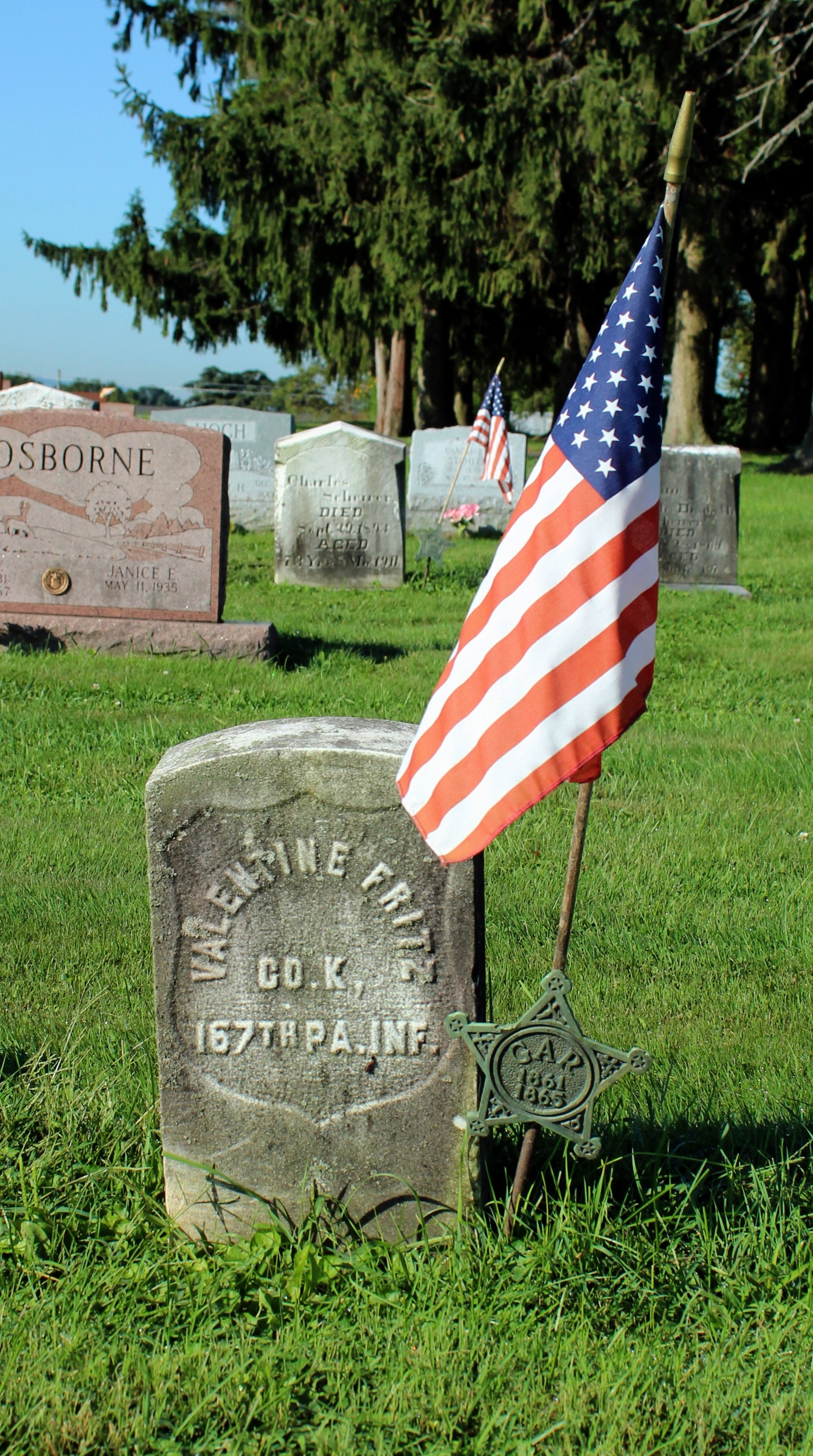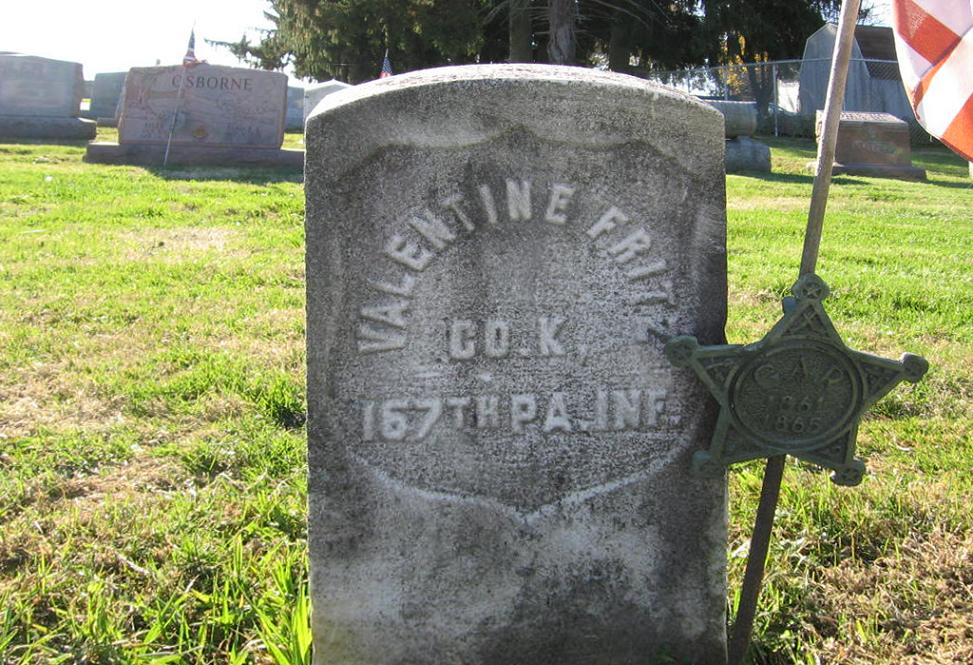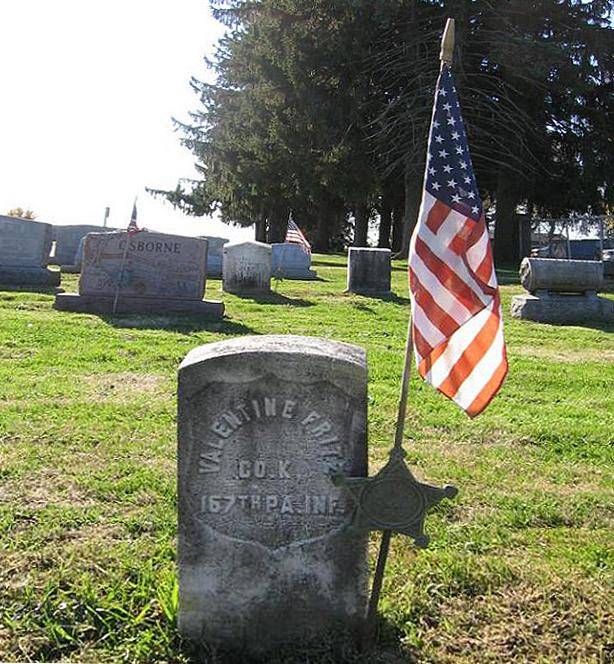After the first year of the war, very few men were volunteering for military service. In order to get enough men to fill their quotas, Pennsylvania and other states had to resort to bounties and the draft. Although Congress did not initiate a draft until 3 March 1863, the state had the authority to draft men for 9 months. Pennsylvania initiated the draft during the fall of 1862. Berks County received its quota and established a system for drafting men and Colonel Henry S. Kupp was appointed Commissioner of the Draft.
In November 1862, the drafted men were ordered to report to Camp Kupp to begin 9 months of service.
One of the draftees ordered to this camp was 42-year-old Reuben B. Brown, the great-great grandfather of the author's wife, Lisbeth A. (Fox) Shugar. It was finding a photograph of him in a Civil War uniform that started this inquiry into the history of the 167th Regiment, where he served as a private in Company I.
The camp was located in a large field known as the "Hiester Farm" just north of Charles Evans Cemetery about equidistant between the Pottsville Turnpike (present day Centre Avenue) and the Reading Railroad tracks.
The work of putting up the tents was started on Monday, 3 November by 2 companies of draftees under the command of Captains Melcher and Drenkle. The men took up permanent residence there on Wednesday, 5 November. A large frame store-house was erected for the commissary near the entrance. The entrance to the camp was on a road leading from the Pottsville Turnpike to the railroad. (This road no longer exists. It ran from the present day intersection of 6th and Richmond Streets to just south of Bern Street at Centre Avenue.)
There were 400 tents neatly pitched on the side of the hill. They were arranged in rows of 20 each. Each company had 16 tents with 6 men in each tent. The tents for the captains and lieutenants were a few yards above the others. Above the tents at the head of each "street" and arranged in line was the cooking department. Here the fires burned briskly and the kettles were filled with first class beef Captain William A. Schall, the commanding officer of Company C noted, "The rations consist of fresh bread and beef 3 times a day. But today we got some crackers. We have sweetened coffee at every meal." A spring for water was located nearby.
Below the line of tents was a level plain used as a parade ground for drill which was held daily from 9 to 10 a.m. The men also learned to build fortifications. Three of the fortifications along the perimeter of the camp were named Forts Bockmuhl, Yost, and Monroe.
Because the camp was on the north side of the hill, it was exposed to the cold winter winds. The newspaper reported that "the coldness has begun already to make itself felt and last night many of the men who were not as well supplied with clothing as they should be, found their tents so uncomfortably cold, that they were induced to go out and spend the night around the kitchen fires."
Later, the name of the camp was changed to Camp Terrill, in honor of General William R. Terrill
About 1400 to 1500 men inhabited the camp. From these men a full regiment of 1,010 men was formed. The remaining men were put into companies to be assigned to another regiment.
The 167th Pennsylvania Regiment was officially mustered into federal service on 4 November 1862 and consisted entirely of men from Berks County. Of the approximately 6,800 men from Berks County that served their country in the Civil War, 1,010 were members of this regiment. Despite this, rather little has been written about the part these brave men played in the defense of the Union.
After the first year of the war, very few men were volunteering for military service. In order to get enough men to fill their quotas, Pennsylvania and other states had to resort to bounties and the draft. Although Congress did not initiate a draft until 3 March 1863, the state had the authority to draft men for 9 months. Pennsylvania initiated the draft during the fall of 1862. Berks County received its quota and established a system for drafting men and Colonel Henry S. Kupp was appointed Commissioner of the Draft.
In November 1862, the drafted men were ordered to report to Camp Kupp to begin 9 months of service.
One of the draftees ordered to this camp was 42-year-old Reuben B. Brown, the great-great grandfather of the author's wife, Lisbeth A. (Fox) Shugar. It was finding a photograph of him in a Civil War uniform that started this inquiry into the history of the 167th Regiment, where he served as a private in Company I.
The camp was located in a large field known as the "Hiester Farm" just north of Charles Evans Cemetery about equidistant between the Pottsville Turnpike (present day Centre Avenue) and the Reading Railroad tracks.
The work of putting up the tents was started on Monday, 3 November by 2 companies of draftees under the command of Captains Melcher and Drenkle. The men took up permanent residence there on Wednesday, 5 November. A large frame store-house was erected for the commissary near the entrance. The entrance to the camp was on a road leading from the Pottsville Turnpike to the railroad. (This road no longer exists. It ran from the present day intersection of 6th and Richmond Streets to just south of Bern Street at Centre Avenue.)
There were 400 tents neatly pitched on the side of the hill. They were arranged in rows of 20 each. Each company had 16 tents with 6 men in each tent. The tents for the captains and lieutenants were a few yards above the others. Above the tents at the head of each "street" and arranged in line was the cooking department. Here the fires burned briskly and the kettles were filled with first class beef Captain William A. Schall, the commanding officer of Company C noted, "The rations consist of fresh bread and beef 3 times a day. But today we got some crackers. We have sweetened coffee at every meal." A spring for water was located nearby.
Below the line of tents was a level plain used as a parade ground for drill which was held daily from 9 to 10 a.m. The men also learned to build fortifications. Three of the fortifications along the perimeter of the camp were named Forts Bockmuhl, Yost, and Monroe.
Because the camp was on the north side of the hill, it was exposed to the cold winter winds. The newspaper reported that "the coldness has begun already to make itself felt and last night many of the men who were not as well supplied with clothing as they should be, found their tents so uncomfortably cold, that they were induced to go out and spend the night around the kitchen fires."
Later, the name of the camp was changed to Camp Terrill, in honor of General William R. Terrill
About 1400 to 1500 men inhabited the camp. From these men a full regiment of 1,010 men was formed. The remaining men were put into companies to be assigned to another regiment.
The 167th Pennsylvania Regiment was officially mustered into federal service on 4 November 1862 and consisted entirely of men from Berks County. Of the approximately 6,800 men from Berks County that served their country in the Civil War, 1,010 were members of this regiment. Despite this, rather little has been written about the part these brave men played in the defense of the Union.
Inscription
Co K 167th PA Inf
Gravesite Details
no dates given, just a military headstone
Advertisement
Explore more
Sponsored by Ancestry
Advertisement




